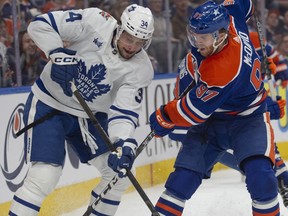Answering all of your questions about the landmark exclusive-rights broadcasting deal

Article content
If you’re a sports fan in Canada, you can’t avoid the domination of Rogers Communications.
Advertisement 2
Story continues below
Article content
Article content
Article content
From arenas, to NHL broadcasts, to ownership stakes in the Toronto Blue Jays (100%) and Maple Leafs (soon to be 75%) the telecommunications giant is in our arenas, on our screens and filling our feeds.
But for all of its multi-million-dollar deals, Rogers has gone next level with its pending deal for its revolutionary 12-year contract extension for national broadcast rights to the NHL in Canada.
READ MORE: Steve Simmons has a few things to say about this new deal
Why is everyone talking about Rogers today?
No, the company didn’t finally shell out to keep Vladimir Guerrero Jr. and Bo Bichette with the Blue Jays. Instead, your once-friendly cable and cell phone company is closing in on landing the biggest rights deal in Canadian sports broadcasting history.
Rogers Communications has reached agreement with the NHL on a 12-year renewal of its current rights deal that, at $11 billion, will more than double the ground-breaking 12-year deal it signed in 2013.
Advertisement 3
Story continues below
Article content
If that original deal was an eye-popping groundbreaker, this one is at least as shocking given those who figured Rogers had no chance to profit from its previous move to become the leading force of Canadian sports broadcasting.
The extension, which still has to be approved by NHL owners (who stand to profit handsomely from the agreement) further cements Rogers’ position as the most dominant player in Canadian sports.
Not only does the company own the Blue Jays and the network that carries their games, they will soon be the majority owner of the Maple Leafs. Rogers CEO Edward Rogers has never been more bullish in his investment (and intent to profit) on Canadian sports than he is right now.
Why would Rogers want to spend so much money?
Everything this company does is by design and that design is to turn a profit.
Just how that can be done on an $11-billion deal is difficult to wrap your head around, but the broadcasting world is a brave, new landscape compared to the one previously confined to prominent spots on your cable package.
Article content
Advertisement 4
Story continues below
Article content
With streaming services becoming all the rage in the major sports — the NFL, NHL and MLB all are expanding in this area — there is the possibility of selling off portions of the national deal in ways not previously explored with aggression.
Article content
Also, with Rogers about to double its 37.5% ownership stake in Maple Leafs Sports and Entertainment by buying out Bell Media’s portion, suddenly they will become an even bigger stakeholder in the NHL’s most-lucrative franchise.
If whatever business model they have in place to turn a profit doesn’t pan out, hey, they can always hike your cable or phone bill to help pay for the pucks.
What about TSN?
The Sports Network, once the more powerful and prominent of the two all-sports broadcasters in Canada had resigned itself to regional-rights deals after losing out to Rogers back in 2013.
That massive shift in the sports broadcasting landscape here didn’t diminish the rivalry between the TSN and Rogers Sportsnet, but it gave the latter the potential to seize the upper hand.
Advertisement 5
Story continues below
Article content
“We said in December 2010 that we wanted to be the No. 1 sports media brand in Canada,” then-Sportsnet president Scott Moore said in an interview with the Sun back in 2014, a year after the stunning and still-ongoing 12-year NHL national rights deal was signed. “Our friends at TSN scoffed. I think it’s fair to say they are not scoffing anymore.”
Not then and not now, given industry rumours that Bell has pondered selling TSN — a point, we note, that has been denied by the parent company.
As it relates to hockey, TSN actually has found a method to thrive after losing out to Rogers in 2013. Without the burden of rights fees, it shifted to a focus on hockey news and breaking stories, which it has done exceptionally well.
That said, the task at being “the voice” of a sport is often seen to be inherently easier for a rights holder.
Meanwhile, it’s important to note that the pending deal is for national rights. Regional deals, which TSN has harvested for Canadian teams, remain a possibility and several already are in place for multiple seasons.
Advertisement 6
Story continues below
Article content
Bell, for example, has a content deal in place with the Maple Leafs through 2033.
How does this compare to the U.S. deal?
Broadcast rights for the NHL have never been as lucrative in the U.S. as in Canada, a reality commissioner Gary Bettman would love to change.
That said, in 2021, the league signed a deal that brings in $625 million US annually and is split between ABC/ESPN, TNT and HBO Max. That deal tripled the previous contract of $200 million paid by NBC.
Isn’t this way more money than Rogers paid in 2012?
It sure is.
But there’s a price to be paid for anything resembling a monopoly, as the folks at Rogers are well aware.
And, remember, telecommunications giants didn’t become behemoths with shoddy business plans.
When it comes to monetizing the new deal, let’s zoom out and examine how the company’s business model with the Toronto Blue Jays has reaped such rewards.
Advertisement 7
Story continues below
Article content
Not only does Rogers own the team and the stadium (Rogers Centre), but it also owns the network that carries all but a handful of its games (Rogers Sportsnet). The resources the company expends on Jays games to flood its platforms with content is massive, with upwards of a dozen reporters and/or broadcasters at Jays home games during the team’s opening home stand.
It’s not the same with a national rights deal, with different and multiple Canadian teams, but the opportunity exists for Rogers to pump more resources into hockey coverage in an attempt to dominate content. How that can be monetized will be different than in baseball, but presumably, with $11 billion as a stake, the company sees opportunities.
What about the struggles Rogers reportedly had with the previous deal?
While the company isn’t about to share its business model — or results — as former executive Moore noted in 2014, owning hockey has the potential for ancillary benefits.
Advertisement 8
Story continues below
Article content
TSN surely would dispute the veracity of some of Sportsnet’s claims, but there’s no doubt that the latter’s profile vaulted significantly after the 2013 deal was signed.
You can argue about the quality of the broadcasts over the years — and indeed the constant shifting of on-air personalities shows it was a work in progress — but that’s the subjective domain of sports fans everywhere who take pleasure in yelling at their TVs.
Recommended from Editorial
What you can’t argue is that one (or two) deep playoff runs by a Canadian NHL team (especially the one in the country’s biggest city) could bring a massive return. And given Rogers’ expanding stake in the Maple Leafs, perhaps the business model looks less fragile than it did a dozen years ago.
Advertisement 9
Story continues below
Article content
What about the streaming platforms?
As much as it is an irritant to fans — and a motivation for cord-cutters (those who cancel their cable subscriptions), the streaming companies are becoming the cash cow of sports broadcasting.
For MLB, the latest partner is Apple TV, which streams Friday night games and blocks viewers (and broadcasters) from the traditional networks for those games. Commissioner Rob Manfred repeatedly has stressed the importance of the partnership.
The NFL has used YouTube, Hulu, Netflix and others as it expands beyond the billions it already collects from mainstream partners CBS, Fox, NBC and ABC/ESPN.
The NHL has used Amazon Prime this season in Canada for its Monday night broadcasts as Rogers sold the rights to the company for games this season and next. Expect similar parceling to continue in the future.
Article content
This post was originally published on this site be sure to check out more of their content.












Comments